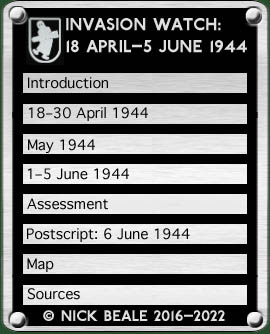|
Coastal radars had been of little help as a post-mortem by the Sea Defence Kommandant for Normandy later explained: On 5/6 at about 2300 [GMT+2] usual individual enemy targets located off the coast were engaged by coastal artillery and driven off. No invasion intentions discernible from remote location. Coastal area alerted only after parachute jumps from 2300 hours on. Sets in Seine Bay jammed by powerful Allied irradiation. General situation therefore obscure … Resumption of location from 0220 onward showed approach of enemy targets in Orne Sector … Enemy irradiation did not finish at 0220 but occasional individual locations were possible in spite of this. Intention of landing became clear through emergence of many targets, particularly from 0305 at a distance of about 10 miles from coast … In response to reports of airborne landings, Luftflotte 3 sent six Fw 190 of I./SKG 10 and three Me 410 of II./KG 51, units accustomed to night operations, on armed reconnaissance. They were reported as taking off from 0156–0224 although one Fw 190 quickly came back with engine trouble. They were over the sea between Cherbourg and Le Havre from 0233–0315 and intense light AA fire encountered after they crossed the coast was thought to be from ships. At 0255 they saw seven groups of ships totalling around 200 vessels and from 0245–0300 signs of fighting on the Cherbourg Peninsula; more ships were seen at 0517. Oberleutnant Helmut Eberspächer of 3./SKG 10 claimed three Lancasters between Saint-Sauveur-le-Vicomte and Saint-Mère-Église while Fw. Eisele claimed a fourth between Cherbourg and Granville. Over the Channel our fighters have flown continuous reconnaissances to establish invasion movements. Seelkriegsleitung, 6 June 1944 Armed reconnaissance: at the start of the invasion, in sea area Cherbourg – Le Havre. First report about the approach of the invasion fleet and the beginning of the invasion from the sea. Proposal to award the Oak Leaves to the Knight’s Cross The 4.(F)/123 sent off two Bf 109 for an offshore reconnaissance at 0414 but they aborted after only eight minutes, having run into 21 Thunderbolts over Dives-sur-Mer. Six of these fighters broke off to engage the German Rotte which found refuge in the clouds. Two hours later the Thames Estuary and eastern end of the Channel were covered with assorted ships being sighted including groups of 30 large landing vessels heading south west. A single Bf 109 flew a security reconnaissance of the Seine Estuary after taking off at 0729 but was driven off by Allied fighters. Trying again at 0856, one Bf 109 managed to sight two destroyers before an encounter with eight Typhoons over Frevaques which forced them to turn back. The Rotte that took off at 1016 broke off after 20 minutes, having sighted a concentration of small vessels which the intervention of Allied fighters prevented them from counting. The Staffel dispatched three more two-plane missions during the afternoon and evening. The first of these, at 1409, managed observations of Le Havre, Honfleur, Trouville, and the beach from Courseulles – Ver (JUNO) and reported “many small ships, stationary” as well as encountering two fighters. The operations at 1540 and 1851 brought no important sightings and were yet again abandoned in the face of Allied fighters. By contrast, an “unusually long recce” (in the words of British Intelligence) by 5.(F)/123 was “conspicuously successful” with a flight by two Bf 109 to the Thames Estuary. Lasting from 0622–0800, this operation made sightings off Orfordness; overflew Margate and Hastings; saw a troop encampment at Dungeness; and covered the Franco-Belgian coast between the Somme Estuary and Ostende. A flight such as this is just what the Germans needed to establish whether Allied landings might also be attempted in the Pas-de-Calais area in the near future. Another Bf 109 reported six LST and six freighters estimated at 36,000 tons in total. Radio traffic indicated that two more operations were mounted during the afternoon but no details emerged. NAG 13 undertook a security reconnaissance of the Western Channel from 0435 with two Bf 109 which saw nothing. At 1116, two more reconnoitred off the Channel Islands and at 1302 at third pair were operated between Carentan and Quinéville. This last mission was intended to ascertain details of the American airborne landings and made numerous sightings of troops and armour before fighters drove them away. The Gruppe was now to be subordinated to Fliegerkorps 2, its role changing to battlefield reconnaissance. Another two aircraft of NAG 13 took off from Dinard at 1300 GMT. The Seekriegsleitung gave this summation at 1030 on the morning of the invasion: The enemy has achieved a certain amount of surprise by landing neither at high water nor in good weather [and] has cut off the invasion area from Northern France by destroying the Seine bridges. Improbable that the main objective of the invasion is occupation of roughly Brittany/Normandy. Far more probable that main blow will take place in the currently favourable conditions for landing, that is high water in the Dunkirk/Dieppe region. Assumption that the enemy will appear there in the coming days, especially if he cannot maintain himself in the Seine Bay. This conclusion is supported by the enemy’s preparation of the area between the Scheldt and the Seine with his very strong air attacks on military installations. There is nothing here to suggest that the physical deception measures distributed across Eastern England—dummy tanks, planes and landing craft—had been caught by German cameras, let alone played any part in this assessment. A map of the Channel Front showing German reconnaissance bases; approximate zones of operation; targets; and locations of crashes. continued on next page …
|
||||



